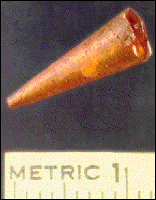Crystal Eases Blue Laser Production
R. Winn HardinTROY, N.Y. -- Researchers at Rensselaer Polytechnic Institute have revived a bit of history in time for the first commercial blue-diode lasers.
Companies hoping to manufacture blue lasers face several significant obstacles, including structural and chemical mismatches between sapphire substrates and gallium nitride active layers. A better solution would be to have a substrate with a similar crystalline structure, said Leo Schowalter, chairman of the institute's physics department .
Glen Slack has had the answer for 20 years. Now a research professor at the institute, he first developed a method to grow bulk aluminum nitride while working at General Electric, but "no one was interested [in nitrides] back then," he said.

To make substrates, the bulk aluminum nitride crystal cone would be cut into 0.5-mm slices. |
Researchers in Poland have had some success at growing gallium nitride platelets -- the best possible solution but the process must be done at 2000 atmospheres and takes three days to produce five to 10 10-mm platelets.
The aluminum nitride process can grow crystals at a rate of 0.3 cm per hour. The group hopes to improve on that rate while expanding the crystal diameter to 5 cm within the next two years.
More than a mechanical base
Aluminum nitride also offers better thermal conductivity than sapphire, meaning that it functions better as a heat sink for diode lasers.
The material also has strong piezoelectric properties that hold promise for the personal communications service industry. Because the acoustic velocity is 10 times that of lithium niobate, aluminum nitride could make possible generations of mobile phones that operate at higher frequencies than today's models.
LATEST NEWS
- Fraunhofer CAP Appoints Head, Scientific Director: People in the News: 1/15/25 Jan 15, 2025
- Bioluminescent Tags Track RNA Dynamics in Live Cells in Real Time Jan 15, 2025
- Sensing and Inspection Specialist EVK Joins Headwall Group Jan 14, 2025
- PHOTON IP Raises $4.9M Seed Round Jan 14, 2025
- Graphene Prevents Damage to Flexible Thin Films for Wearable Electronics Jan 14, 2025
- Thorlabs Acquires VCSEL Developer, Longtime Partner Praevium Research Jan 13, 2025
- Electrically-Pumped GaAs-Based Nano-Ridge Lasers Fabricated at Wafer Scale Jan 13, 2025
- Photoactivated Gel Achieves Bone Regeneration and Adhesion at Same Time Jan 13, 2025
